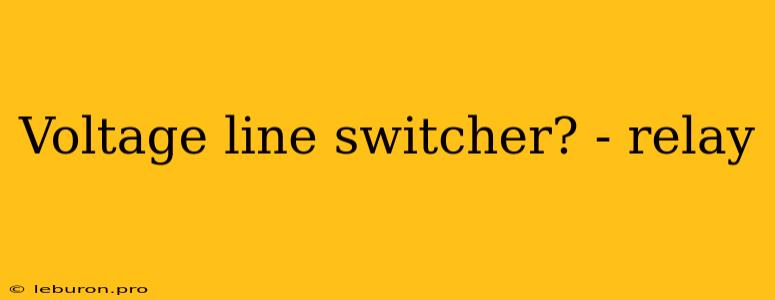The Role of Relays in Voltage Line Switchers: Ensuring Seamless Power Transitions
Voltage line switchers are essential components in electrical systems, ensuring continuous and reliable power supply by automatically switching between different voltage sources. These systems are crucial for various applications, ranging from industrial machinery and critical infrastructure to sensitive electronic devices and data centers. The heart of a voltage line switcher lies in its ability to seamlessly transition between sources, and this is where relays play a pivotal role. Relays act as the switching mechanism, enabling the transfer of power from one source to another with minimal disruption. This article delves into the critical role of relays in voltage line switchers, exploring their different types, functionalities, and the benefits they bring to power management.
Understanding Voltage Line Switchers and Their Purpose
Voltage line switchers are designed to provide uninterrupted power supply by automatically switching between multiple voltage sources. These sources can include generators, battery backups, or even different power grids. The primary goal of a voltage line switcher is to maintain a continuous and stable power supply, even in the event of a power outage or voltage fluctuations. They achieve this by monitoring the input voltage and automatically transferring the load to a backup source when the primary source fails or experiences instability.
The Crucial Role of Relays in Voltage Line Switchers
Relays are electromechanical switches that use an electromagnetic coil to control the opening and closing of electrical contacts. When an electrical current flows through the coil, it creates a magnetic field that attracts a movable armature, which in turn opens or closes the contacts. Relays are essential in voltage line switchers because they enable the automatic switching between different voltage sources with high speed and reliability.
Types of Relays Used in Voltage Line Switchers
Electromagnetic Relays: These relays are the most common type used in voltage line switchers. They are relatively inexpensive, reliable, and capable of switching high currents.
Solid-State Relays (SSRs): SSRs use semiconductor devices to control the switching action. They offer advantages like faster switching speeds, lower noise, and longer lifespan compared to electromagnetic relays.
Reed Relays: Reed relays use hermetically sealed contacts that are ideal for applications requiring high reliability and resistance to environmental factors.
How Relays Function Within a Voltage Line Switcher
- Monitoring Input Voltage: The voltage line switcher continuously monitors the voltage from the primary source.
- Triggering the Relay: When the primary source voltage falls below a predetermined threshold or experiences a fault, the control circuit triggers the relay.
- Switching to Backup Source: The activated relay opens the circuit connected to the primary source and simultaneously closes the circuit connected to the backup source, transferring the load.
- Maintaining Continuity: The relay ensures a seamless transition between sources, minimizing any interruption to the power supply.
Key Benefits of Relays in Voltage Line Switchers
- Reliability: Relays provide high reliability, ensuring that the switching process is accurate and efficient.
- Speed: Relays can switch between sources very quickly, minimizing downtime.
- Isolation: Relays provide electrical isolation between the control circuit and the high-power circuits, enhancing safety.
- Flexibility: Relays can be easily integrated with different control systems and provide versatile switching configurations.
- Durability: Relays are designed for long service life and can withstand harsh operating conditions.
Choosing the Right Relay for Your Voltage Line Switcher
The selection of the appropriate relay for a voltage line switcher depends on several factors:
- Voltage and Current Rating: The relay must be rated to handle the voltage and current of the circuits it is switching.
- Switching Speed: The required switching speed depends on the sensitivity of the load and the allowable interruption time.
- Environmental Conditions: The operating environment may dictate the choice of relay type, considering factors like temperature, humidity, and electromagnetic interference.
- Contact Material: The contact material affects the relay's durability and resistance to corrosion.
- Cost: The cost of the relay should be balanced against its performance and reliability.
Conclusion: Relays as the Backbone of Reliable Power Management
Relays are the heart of voltage line switchers, enabling them to provide seamless and reliable power transitions between different sources. Their ability to switch high currents quickly and reliably, coupled with their durability and versatility, makes them essential components in ensuring continuous power supply for various applications. By understanding the role of relays in voltage line switchers, engineers and technicians can design and implement power management systems that meet the specific needs of their applications, guaranteeing reliable and efficient power delivery.
